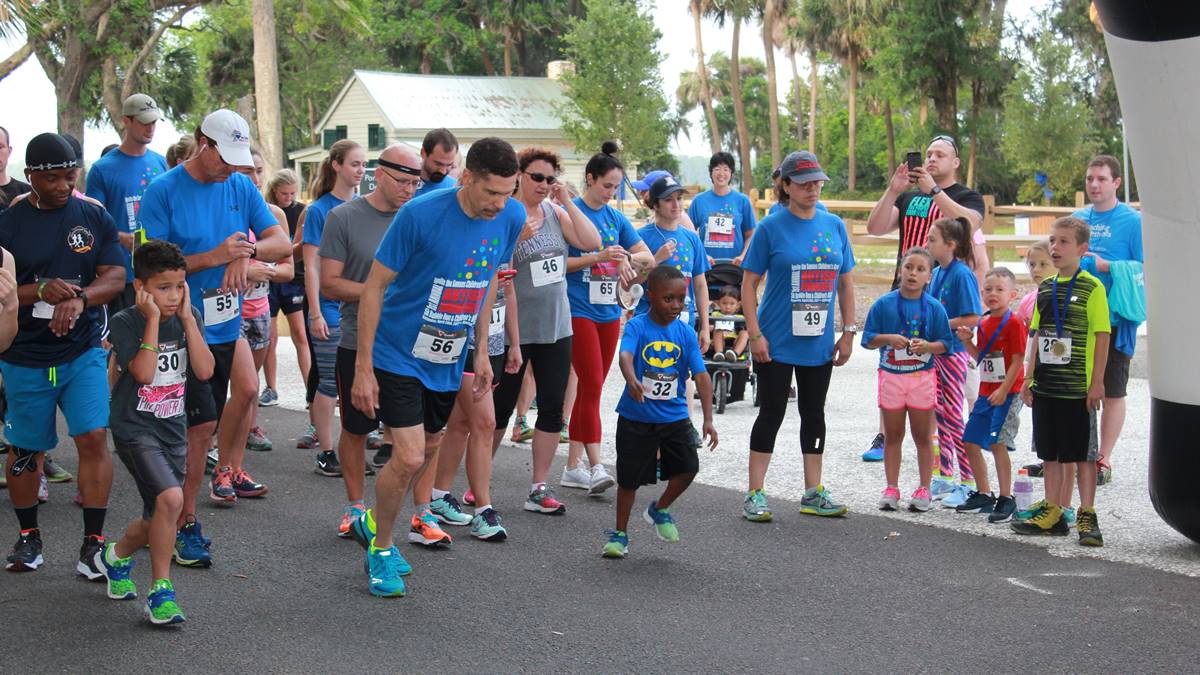

Featured
What Is The Overhead Cost Of A 5K Run
Published: August 29, 2023
Discover the overhead cost of organizing a 5K run and explore the featured expenses in this informative guide. Gain insights into budget planning and optimize your event's success.
Introduction
Welcome to the world of 5K runs, where the thrill of competition, the joy of accomplishment, and the support of a community come together. Whether you are a seasoned runner or a novice looking to challenge yourself, participating in a 5K run can be a memorable and rewarding experience. But have you ever wondered what goes on behind the scenes to make such an event possible?
In this article, we will explore the concept of overhead costs in the context of a 5K run. Every event, including a 5K run, involves various expenses that are essential for its smooth operation. These costs, collectively known as overhead costs, play a crucial role in ensuring that the event is well-organized, safe, and enjoyable for all participants.
Understanding the concept of overhead costs is essential not only for event organizers but also for participants who want to gain insight into the behind-the-scenes efforts and the logistics involved in organizing a successful 5K run. By having a deeper understanding of these costs, participants can appreciate the value they receive from their entry fees and event sponsors for the overall experience.
The purpose of this article is to shed light on the overhead costs involved in organizing a 5K run. We will discuss the various factors that impact these costs, including venue rental and permits, event staffing, marketing and advertising, supplies and equipment, insurance and legal fees, registration and administrative costs, refreshments and aid stations, as well as awards and prizes. By learning about these factors, you will gain a comprehensive understanding of the financial aspects of organizing and participating in a 5K run.
So, are you ready to delve into the world of overhead costs of a 5K run? Let’s get started!
Understanding Overhead Costs
Before we dive into the specific overhead costs involved in organizing a 5K run, let’s first establish a clear understanding of what overhead costs actually are. In a general sense, overhead costs refer to the expenses incurred by a business or organization to support its daily operations, without directly being tied to the production of goods or services. In the context of a 5K run, overhead costs encompass all the necessary expenses that contribute to the successful planning and execution of the event.
Overhead costs can be divided into two main categories: fixed costs and variable costs. Fixed costs are those that remain constant regardless of the number of participants, such as venue rental or permits. Variable costs, on the other hand, fluctuate based on the scale and scope of the event, like the amount of supplies and equipment needed.
It’s important to note that overhead costs are different from direct costs. Direct costs are directly attributable to the production or provision of goods or services. In the case of a 5K run, direct costs would include expenses like timing systems, race bibs, medals, and T-shirts. While these direct costs are essential, overhead costs cover the broader operational expenses required to make the event possible.
Overhead costs play a significant role in the overall success and experience of a 5K run. They ensure that the event is well-organized, safe, and enjoyable for everyone involved. While it may seem like the entry fee covers all the necessary expenses, it’s crucial to understand that overhead costs are an essential part of the financial equation. By understanding and appreciating these costs, participants can gain a deeper insight and appreciation for the behind-the-scenes efforts put into organizing such an event.
Now that we have a clear understanding of overhead costs, let’s explore the specific factors that impact these costs when organizing a 5K run. From venue rental and permits to event staffing, marketing and advertising, and much more, each factor contributes to the overall overhead cost of the event. Join us in the next section as we take a closer look at these contributing factors.
The Significance of a 5K Run
A 5K run holds a special place not only in the world of running but also in the hearts of participants and organizers. It is a popular distance for runners of all levels, from beginners seeking their first challenge to seasoned athletes looking to test their speed and endurance. Beyond its athletic appeal, a 5K run also serves a broader purpose and holds significant significance in various ways.
First and foremost, a 5K run promotes physical fitness and encourages a healthy lifestyle. It serves as a goal-setting platform for individuals to push their limits, maintain discipline in training, and achieve personal milestones. The inclusive nature of a 5K run allows people of all ages and fitness levels to participate, reinforcing the notion that exercise and fitness are for everyone.
Additionally, a 5K run often serves as a fundraising opportunity for charitable causes and nonprofit organizations. Participants can choose to run on behalf of a specific cause, soliciting donations from friends, family, and colleagues to support their chosen charity. This aspect of a 5K run not only raises funds but also creates awareness and supports important social causes.
Moreover, a 5K run fosters a sense of community and camaraderie. It brings together people from different backgrounds, ages, and abilities under a common goal. The shared experience of running side by side, cheering for one another, and celebrating achievements creates a sense of unity and connection. Many 5K runs also incorporate family-friendly activities, making it an event for everyone to enjoy, from young children to grandparents.
From an organizational perspective, a 5K run provides an opportunity to showcase a community or location. It can serve as a tourism attraction, bringing participants from near and far to explore the local sights and culture. Additionally, a successful 5K run can enhance the reputation of the organizers and sponsors by demonstrating their commitment to promoting health, wellness, and community engagement.
Overall, the significance of a 5K run reaches far beyond the physical act of running. It promotes health, fitness, and personal goals while raising awareness for important causes and fostering a sense of community. As we explore the overhead costs involved in organizing a 5K run, it is important to keep in mind the significant impact and value that these events hold.
Now that we understand the significance of a 5K run, let’s delve into the various factors that impact the overhead costs associated with organizing such an event.
Factors Impacting Overhead Costs in a 5K Run
Organizing a 5K run involves various factors that can significantly impact the overhead costs. These factors encompass everything from securing a suitable venue, managing event staffing, and marketing the event to acquiring necessary supplies and ensuring legal compliance. Understanding these factors can provide valuable insights into the financial considerations involved in organizing a successful 5K run.
One of the primary factors impacting overhead costs is venue rental and permits. The cost of renting a venue, such as a park or a designated race course, can vary based on location, size, and amenities. Additionally, obtaining the necessary permits and insurance for the event can incur additional expenses.
Event staffing is another significant factor influencing overhead costs. Hiring event management professionals, as well as securing volunteers, is essential for ensuring a smooth and well-organized event. The size of the event and the complexity of its operations can affect the staffing needs and, consequently, the associated costs.
Marketing and advertising play a crucial role in attracting participants and sponsors to a 5K run. Effective promotional strategies, including online and offline advertising, social media marketing, and printed materials, can contribute to the overall success of the event. However, investing in marketing efforts can also add to the overhead costs.
Supplies and equipment required for a 5K run can vary based on the scale and nature of the event. This includes items such as race bibs, timing systems, medals, T-shirts, and safety equipment. Depending on the number of participants and the desired quality of these items, the associated costs can vary significantly.
Ensuring legal compliance and obtaining the necessary insurance coverage are vital aspects of organizing a 5K run. Insurance and legal fees can add to the overhead costs, but they are essential for mitigating potential risks and protecting the organizers and participants.
Registration and administrative costs are also factors to consider when budgeting for a 5K run. This includes expenses related to online registration platforms, payment processing fees, participant communication, and administrative tasks like data management and participant check-in.
Providing refreshments and aid stations for the participants is another cost factor to consider. Depending on the duration and location of the run, organizers need to plan for water stations, energy drinks, snacks, and medical assistance to ensure the well-being and satisfaction of the participants.
Lastly, awards and prizes play an important role in recognizing participants’ achievements and motivating them to perform their best. The cost of medals, trophies, certificates, and other recognition items can contribute to the overhead costs of a 5K run.
Understanding these factors and their impact on overhead costs allows organizers to plan and budget effectively for a 5K run. By considering these factors, organizers can deliver a well-executed event that meets the participants’ expectations while managing and optimizing the associated expenses.
Now that we have examined the various factors impacting overhead costs let’s explore each of them in more detail, starting with venue rental and permits.
Venue Rental and Permits
Choosing a suitable venue for a 5K run is a crucial step in organizing a successful event. The venue sets the stage and provides the necessary infrastructure to accommodate participants, spectators, and event operations. However, securing a venue and obtaining the required permits can incur significant overhead costs.
Venue rental costs can vary depending on factors such as location, size, amenities, and duration of use. Popular venues or those in high-demand locations may come with a higher price tag. It is essential to consider the budget and estimated number of participants when selecting a venue to ensure it can comfortably accommodate the expected crowd.
In addition to the rental cost, securing permits is an important part of the venue acquisition process. Various permits may be required depending on local regulations and the nature of the event. These permits ensure that the event complies with safety standards and guidelines, mitigating potential risks. The cost of permits can vary depending on the region and may include fees for road closures, park usage, noise permits, and more.
Furthermore, insurance coverage is often a prerequisite for obtaining permits and renting a venue. Event organizers need to provide proof of liability insurance to protect themselves, participants, and the venue against unforeseen accidents or incidents. Insurance fees can contribute to the overall overhead costs of the event.
To minimize venue rental and permit costs, event organizers can explore various options. Seeking sponsorship or partnership agreements with local businesses or organizations may reduce or even eliminate the rental fee. Building relationships with community leaders and gaining support from local authorities can also lead to reduced permit costs or waived fees for certain aspects of the event.
Additionally, organizers can consider alternative venues that may offer more affordable or flexible rental options. Local parks, school tracks, or private properties can be viable alternatives to traditional event venues, potentially reducing overhead costs. However, it is important to ensure that these alternative venues can accommodate the desired number of participants and meet safety requirements.
In summary, venue rental and permits are key factors impacting overhead costs in organizing a 5K run. The cost of renting a suitable venue and obtaining the required permits can vary based on factors such as location, size, and duration. Additionally, insurance coverage is often necessary to secure permits and protect all stakeholders involved. By considering alternative venues, seeking partnerships, and building relationships with local authorities, event organizers can effectively manage these costs and ensure a successful and cost-efficient 5K run.
Event Staffing and Volunteer Management
Organizing a 5K run requires a dedicated team of event staff and volunteers to ensure a smooth and well-organized event. Effectively managing event staffing and volunteers is crucial for the successful execution of the run. However, these staffing requirements come with associated overhead costs that should be considered in the event budget.
Event staffing includes hiring professionals to handle various aspects of the event, such as event coordinators, race directors, timers, medical personnel, and security. The size and complexity of the event will determine the number of staff members required. These professionals bring expertise and experience to the event, ensuring its efficient and effective management. Staffing costs can vary based on market rates and the duration of their services.
Volunteers, on the other hand, play a vital role in supporting various operational aspects of the event. Volunteers may be responsible for tasks such as packet pick-up, participant check-in, course marshaling, water station management, and distributing medals or refreshments. The number of volunteers needed will depend on the event’s scale and the level of participant support required. Organizers may recruit volunteers from local community groups, schools, or other organizations. While volunteers are not typically paid, the overhead costs associated with managing and coordinating their efforts should be considered.
Effectively managing event staffing and volunteers involves clear communication, training, and coordination. Organizers must allocate time and resources to recruit, train, and supervise staff and volunteers. This may include providing training materials, conducting briefings, and coordinating schedules. Proper management ensures that everyone understands their responsibilities and contributes to a smooth and memorable event experience for participants.
To minimize staff and volunteer management costs, organizers can explore various strategies. Seeking sponsorship or partnerships with local businesses can enable organizers to secure discounted or even pro bono services from professionals. Additionally, building relationships in the community and having a strong network can help recruit dedicated volunteers who are willing to contribute their time and skills without any monetary compensation.
Technology can also play a role in reducing staffing costs. Utilizing online registration platforms, automated timing systems, and communication tools can streamline processes and minimize the need for additional manpower. However, it is important to strike a balance between leveraging technology and ensuring a personal touch, as participant engagement and satisfaction depend on the human aspect of the event.
In summary, event staffing and volunteer management are integral components of organizing a 5K run. The costs associated with hiring event professionals and coordinating volunteers should be considered in the event budget. Through cost-effective strategies like seeking sponsorships, partnerships, and leveraging technology, organizers can effectively manage these costs while ensuring a well-executed and memorable 5K run.
Marketing and Advertising
Marketing and advertising play a critical role in attracting participants, sponsors, and supporters to a 5K run. Effective promotion of the event is essential for its success, but it also comes with associated overhead costs that should be considered in the event budget.
Developing a comprehensive marketing strategy is key to reaching the target audience and generating interest in the event. This can include online and offline advertising, social media campaigns, email marketing, and collaborations with relevant influencers or publications. The cost of these promotional efforts can vary depending on the platforms used, the scope of the campaign, and any associated fees for graphic design, copywriting, or ad placement.
While digital marketing has become increasingly important, traditional methods should not be overlooked. Printed promotional materials, such as flyers, posters, and banners, can be distributed in local businesses, community centers, and popular running routes. Additionally, collaborating with local media outlets, radio stations, or television channels can generate additional exposure for the event.
Investing in sponsored posts or advertisements on social media platforms can also help increase visibility and engagement. Platforms like Facebook, Instagram, and Twitter offer targeting features that allow event organizers to reach a specific audience based on location, interests, and demographics. These advertising options can be effective in reaching a large number of potential participants but require careful budgeting to optimize results.
Another important aspect of marketing a 5K run is engaging participants and sponsors through a well-designed event website and active social media presence. The website should provide essential information such as date, location, registration details, and FAQs, while also highlighting the unique aspects and benefits of the run. Social media platforms can be used to share updates, feature inspiring stories of participants, and encourage community interaction.
Building relationships with local businesses and community organizations can also contribute to the marketing efforts. Sponsoring and participating in community events, partnering with local gyms or sports clubs, and offering discounts or promotional codes can help generate buzz and attract participants. Collaborating with sponsors can also lead to co-branded marketing campaigns, sharing resources and reaching wider audiences.
Monitoring the effectiveness of marketing efforts is crucial to allocate resources efficiently. Organizers should track the return on investment (ROI) of different marketing channels and adjust their strategy accordingly. This can be done by monitoring registration numbers, tracking website and social media analytics, and soliciting feedback from participants.
In summary, marketing and advertising are essential components of a successful 5K run but come with associated overhead costs. By developing a comprehensive marketing strategy, leveraging both digital and traditional advertising methods, and building strong community relationships, organizers can effectively promote their event while managing marketing expenses. Monitoring the effectiveness of marketing efforts enables organizers to optimize their strategy and reach a wider audience, maximizing participant engagement and support.
Supplies and Equipment
When organizing a 5K run, having the necessary supplies and equipment is essential to ensure a smooth and successful event. These items contribute to the overall participant experience, safety, and operational efficiency. However, acquiring and managing supplies and equipment comes with associated overhead costs that should be considered in the event budget.
The specific supplies and equipment needed may vary depending on the scale and nature of the event. Some essential items include race bibs, timing systems, medals, T-shirts, safety cones or barriers, water station supplies, signage, and medical kits. The quantity and quality of these items will depend on the number of participants, event logistics, and desired level of participant support.
The cost of supplies and equipment can vary based on factors such as quantity, quality, and customization. Investing in high-quality items may lead to a better participant experience and longer durability, but it can also come at a higher cost. Organizers need to strike a balance between cost and quality to ensure a well-equipped event while staying within the budget.
In addition to procurement, storage, and transportation costs, organizers should also consider the potential for loss, damage, or replenishment of supplies. It is crucial to plan for contingencies and have a budget for ongoing maintenance or replacement of items as needed.
One way to manage the costs of supplies and equipment is by leveraging partnerships or sponsorships. Seeking collaborations with companies that specialize in event equipment rentals or have an interest in supporting community initiatives can help reduce upfront costs. Building relationships with local businesses and exploring sponsorship opportunities can result in discounts, donations, or even free provision of certain items.
Organizers should also consider the environmental impact of using certain supplies and equipment. Opting for eco-friendly options, such as biodegradable race bibs, reusable cups, or recyclable materials, can mitigate environmental damage and align with the values of participants and sponsors.
Efficient inventory management is essential to avoid unnecessary costs and ensure that supplies and equipment are readily available when needed. Keeping track of inventory levels, monitoring usage patterns, and having a system for replenishment or redistribution of supplies contributes to cost-efficiency.
Lastly, evaluating participant feedback and conducting post-event analysis can provide valuable insights into the effectiveness and cost-effectiveness of the supplies and equipment used. Participant satisfaction surveys and post-event meetings can help identify areas for improvement or identify opportunities to optimize the allocation of resources in future events.
In summary, supplies and equipment are crucial components of organizing a 5K run but should be managed efficiently to control overhead costs. By carefully selecting and procuring items, exploring partnerships or sponsorships, considering environmental impact, and maintaining effective inventory management, organizers can ensure a well-equipped event while optimizing expenses. Regular evaluation and post-event analysis contribute to continuous improvement and cost-efficiency in future events.
Insurance and Legal Fees
When organizing a 5K run, ensuring the safety and well-being of participants, staff, and volunteers is of utmost importance. That’s where insurance coverage and legal considerations come into play. While these aspects of event planning may add to the overhead costs, they are crucial for mitigating risks, protecting stakeholders, and ensuring compliance with legal requirements.
Insurance coverage is essential to protect against potential accidents, injuries, or damages that may occur during the 5K run. General liability insurance provides coverage for accidents or injuries that participants, staff, or volunteers may sustain during the event. It also safeguards against damages to property or third-party claims. The cost of insurance premiums can vary based on factors such as the number of participants, the nature of the event, and the desired coverage limits.
Additionally, organizers may need to consider workers’ compensation insurance if they hire staff or have paid volunteers involved in the event. Workers’ compensation insurance provides coverage for medical expenses and lost wages for employees or volunteers who may suffer injuries while on the job.
Legal fees are another aspect to consider when organizing a 5K run. Event organizers may need legal guidance or assistance to navigate contracts, waivers, permits, and other legal documents. Consultation with legal professionals can help ensure compliance with local laws and regulations, reduce potential liabilities, and protect the rights of all parties involved. Legal fees can vary depending on the complexity and scope of the event.
Additionally, some venues or municipalities may require specific permits or waivers, adding to the legal considerations and associated costs. These permits and waivers are essential for ensuring compliance with local laws, minimizing risks, and addressing liability issues.
To manage insurance and legal fees, event organizers can explore several strategies. One approach is to engage with insurance brokers or agents who specialize in event coverage. These professionals can help select appropriate coverage options and negotiate competitive premiums. Seeking multiple quotes from different insurance providers can also help compare costs and coverage options to find the best fit for the event’s needs.
When it comes to legal fees, organizers can consider seeking pro bono advice from legal professionals who have an interest in supporting community events. Building relationships with local law firms or law schools can lead to reduced fees or even free legal services. It is important to be proactive and seek legal guidance early in the planning process to ensure compliance and reduce potential risks.
In summary, insurance coverage and legal considerations are essential for mitigating risks and ensuring compliance in the organization of a 5K run. While these aspects contribute to the overhead costs, they are vital for protecting participants, staff, and volunteers, as well as minimizing potential liabilities. By engaging insurance brokers, exploring competitive options, seeking pro bono legal advice, and being proactive in addressing legal considerations, organizers can effectively manage these costs while prioritizing the safety and well-being of all involved.
Registration and Administrative Costs
Registration and administrative processes are integral to organizing a 5K run, ensuring a smooth and efficient experience for participants. While these aspects may seem straightforward, they do come with associated overhead costs that should be considered in the event budget.
Registration costs include expenses related to setting up an online registration platform or utilizing a third-party registration service. These platforms allow participants to sign up for the event, provide necessary information, and process payment. Registration costs may include fees for platform usage, credit card processing fees, and any additional features or customization required.
It is important to carefully choose a reliable and user-friendly registration platform that meets the specific needs of the event. Evaluating the features, ease of use, security measures, and customer support of different platforms can help ensure a seamless registration process for participants while managing costs.
Administrative costs encompass various tasks and activities throughout the planning and execution of the 5K run. This can include expenses related to participant communication, data management, volunteer coordination, participant package preparation, and day-of logistics. These costs may involve hiring administrative staff or dedicating staff time to handle these responsibilities.
Additionally, organizers need to allocate resources for participant materials, such as race packets, bibs, goody bags, and event guides. Printing and packaging these materials can contribute to the administrative costs of the event. Careful planning and budgeting can help optimize these expenses and ensure that participants receive high-quality materials within the allocated budget.
One way to manage registration and administrative costs is to centralize and automate tasks as much as possible. Utilizing online registration platforms reduces the need for manual data entry and payment processing. Automated systems for participant communication, such as confirmation emails or pre-event information, can also streamline administrative efforts and reduce costs.
Partnering with sponsors or local businesses can offset some of the registration and administrative costs. Sponsors may be interested in supporting the event by covering or subsidizing registration or administrative expenses in exchange for brand exposure or other promotional opportunities. Collaborating with local printers, office supply stores, or event service providers can also result in discounts or sponsorship agreements, reducing overhead costs.
Lastly, conducting post-event evaluations and seeking participant feedback can help identify areas for improvement and cost-saving opportunities in registration and administrative processes. Analyzing the efficiency of the registration platform, identifying bottlenecks or pain points in the administrative workflow, and implementing necessary changes can lead to cost optimization in future events.
In summary, registration and administrative costs are important aspects of organizing a 5K run. By carefully selecting and utilizing a reliable registration platform, automating administrative tasks, seeking sponsorships, and regularly evaluating processes, organizers can effectively manage these costs while ensuring a seamless and efficient experience for participants. Efficient registration and administrative processes contribute to the overall success and satisfaction of the event.
Refreshments and Aid Stations
Providing refreshments and aid stations is an important consideration in organizing a 5K run. These elements contribute to the overall participant experience, ensuring that runners stay hydrated, fueled, and supported throughout the event. However, offering refreshments and aid stations comes with associated overhead costs that need to be considered in the event budget.
Aid stations play a crucial role in supporting participants during the run. They provide water, sports drinks, and sometimes snacks or energy gels to replenish fluids and provide necessary energy. The cost of setting up aid stations can include the purchase of water or drinks, cups, tables, and signage. The number and placement of aid stations will depend on the event’s distance, course layout, and expected number of participants.
Organizers may also consider providing additional resources at aid stations, such as first aid supplies, ice, sponges, squeegees, or medical personnel. These resources can contribute to the safety and well-being of participants. The cost associated with these additional resources should be factored into the overall overhead expenses of the event.
Refreshments beyond aid stations can also be offered to participants after completing the run. This can include post-run snacks, fruit, water, or sports drinks to help runners recover and refuel. The cost of providing these refreshments will depend on the number of participants and the selected menu items. Additionally, organizers may also choose to offer special dietary options or accommodate specific dietary restrictions, which should be included in the budgeting process.
To manage the costs of refreshments and aid stations, organizers can explore partnerships or sponsorships with local businesses or food suppliers. Establishing partnerships can result in discounted or donated food and beverage items, reducing the financial burden on the event budget. Collaborating with local businesses can also provide an opportunity for cross-promotion and community engagement.
Efficient planning and budgeting for refreshments and aid stations include estimating the number of participants, anticipated consumption, and waste. Minimizing food and beverage waste helps reduce costs and supports sustainability efforts. Determining the optimal quantities of items based on previous event data and participant feedback can help strike the right balance between meeting participant needs and managing costs efficiently.
Finally, collecting participant feedback on refreshments and aid stations is crucial for continuous improvement. Evaluating the quality and variety of the offerings, as well as the efficiency of aid station setups and positioning, can help identify areas for enhancement. Taking participant feedback into consideration for future events can result in cost savings and an improved participant experience.
In summary, providing refreshments and aid stations is an important aspect of organizing a 5K run. By carefully planning the number and placement of aid stations, exploring partnerships or sponsorships for food and beverage items, and gathering participant feedback for continuous improvement, organizers can effectively manage the costs associated with refreshments and aid stations while ensuring a positive and well-supported participant experience.
Awards and Prizes
Awards and prizes are an exciting aspect of 5K runs, recognizing the accomplishments of participants and adding an element of friendly competition. Offering awards and prizes not only motivates runners to give their best but also enhances the overall participant experience. However, including awards and prizes in a 5K run comes with associated overhead costs that need to be considered in the event budget.
The types of awards and prizes can vary depending on the event and the target audience. Common awards include medals, trophies, certificates, or plaques for top finishers overall, in various age categories, or for specific achievements, such as the fastest male or female participant. The cost of these awards will depend on the materials used, customization, and the number of recipients.
In addition to physical awards, organizers may choose to offer prizes in the form of cash, gift cards, or merchandise. Prizes can be given to top finishers, winners of raffles or contests, or participants with exceptional achievements or charitable fundraising efforts. The cost of prizes will depend on the value and quantity of the items selected.
When budgeting for awards and prizes, organizers should consider the number of participants, the significance of the event, and the desired level of recognition. This will help determine the appropriate allocation of resources to ensure memorable and meaningful awards without overspending.
To manage the costs, organizers can seek sponsorships or partnerships with companies or organizations interested in supporting the event or gaining exposure through sponsorship. Sponsors may be willing to contribute funds or provide in-kind donations for awards and prizes in exchange for promotional opportunities or branding at the event. Collaborating with local businesses or sports equipment suppliers can also lead to discounted or donated prizes.
Organizers can also explore creative alternatives for awards and prizes that align with the event’s theme or purpose. For example, instead of traditional medals or trophies, personalized items, such as engraved water bottles or custom-designed medals, can provide unique and cost-effective rewards.
Another consideration for awards and prizes is to focus on sustainability. Choosing environmentally friendly materials, such as recycled or biodegradable options, aligns with the increasing trend of eco-consciousness and minimizes the environmental impact of the event. This can contribute to a positive image and appeal to participants and sponsors who prioritize sustainability.
Finally, collecting participant feedback and conducting post-event evaluations can help assess the effectiveness and value of the awards and prizes offered. Understanding participant preferences and expectations can guide future decision-making, ensuring the allocation of resources in a way that best meets the desires of participants.
In summary, awards and prizes add excitement and motivation to a 5K run, but they also come with associated costs. By carefully budgeting for awards, exploring sponsorships or partnerships, considering sustainable options, and gathering participant feedback, organizers can manage the costs of awards and prizes while creating a memorable and rewarding experience for participants.
Conclusion
Organizing a 5K run involves a range of overhead costs that are essential for the successful planning and execution of the event. Understanding and managing these costs is crucial for event organizers and participants alike. By delving into the various factors that impact overhead costs, including venue rental and permits, event staffing, marketing and advertising, supplies and equipment, insurance and legal fees, registration and administrative costs, refreshments and aid stations, as well as awards and prizes, organizers can effectively plan and budget for a well-organized and memorable 5K run.
The significance of a 5K run transcends the physical act of running. It promotes fitness, goal-setting, community engagement, and charitable causes, uniting participants from different backgrounds and abilities. As such, it is important for organizers to understand and appreciate the value of the overhead costs that contribute to creating a meaningful and enjoyable event experience.
Throughout the planning process, organizers can explore various strategies to manage overhead costs. Seeking sponsorships, leveraging partnerships, incorporating sustainable practices, and utilizing technology can help optimize expenses without compromising the quality and impact of the event.
Participant feedback and post-event analysis are invaluable for continuous improvement. Evaluating the effectiveness of various cost considerations, such as registration processes, refreshments, and aid stations, enables organizers to make data-driven decisions and enhance future events.
In conclusion, thorough understanding and management of overhead costs are key to organizing a successful 5K run. By carefully considering the factors impacting these costs, exploring cost-saving opportunities, and prioritizing participant experience and safety, event organizers can create an engaging and well-executed event while ensuring financial sustainability.








